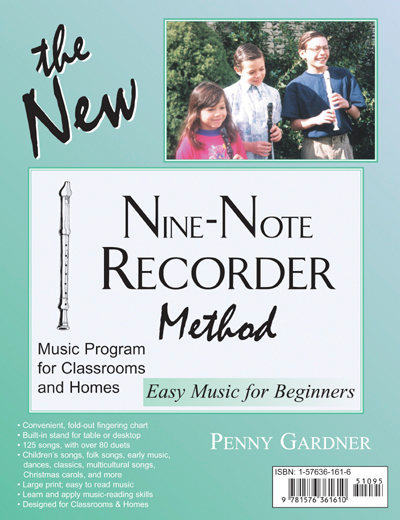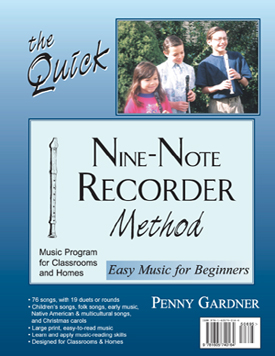|
 There is no question that recorder instruction begins with B, A, and G. But the debate rages over whether the next notes learned should be higher or lower. There is no question that recorder instruction begins with B, A, and G. But the debate rages over whether the next notes learned should be higher or lower.
Those who think going up to high C and D should be taught next have their reasons. Namely, going down means going to F. On soprano recorder, F is tricky to finger: forked (fingers 1, 3 and 4) for F natural; or bunny-ears, or long horns, (fingers 2 and 3) for F sharp.
Some instructors choose German-fingered recorders rather than Baroque recorders to avoid the challenging F fingering. However, German recorders are not in tune. Another big drawback is that students who continue with recorder must re-learn in the Baroque fingering system to play in an ensemble.
Other instructors believe that the logical choice after B, A, G is to go down. In The Nine-Note Recorder Method, low E is presented next. Low E is easy to finger and to play. This involves the right hand very early in the course. Right-handed youngsters resist playing recorder with the left hand on the top because they want to use their dominant hand. By introducing low E as the next note, right-handed students more accepting of the correct hand placement.
The next note presented is low D. The fingering is easy; simply add the 3rd finger. Students must be taught to aim their air stream low and to blow softly, as over-blowing will produce the tone an octave higher. Going down to E and D keeps more contact with the instrument, whereas high C and D have very little contact with the instrument causing a loss of control.
After thoroughly learning these 5 notes by playing many pentatonic songs, students have developed familiarity with the recorder, more dexterity, and more confidence. F sharp is the next note presented. Completely avoiding F natural, only F sharp is presented in The Nine-Note Recorder Method.  Those methods which use F natural must also teach B flat (and you thought F natural was tricky!) and low C (which makes producing low D look easy and is quite a stretch for little hands). Beginners should only learn the easiest notes to experience success B flat and low C are two very difficult notes, causing frustration. Those notes, and more, are learned in the intermediate volume, Beyond the Nine-Note Recorder Method. Those methods which use F natural must also teach B flat (and you thought F natural was tricky!) and low C (which makes producing low D look easy and is quite a stretch for little hands). Beginners should only learn the easiest notes to experience success B flat and low C are two very difficult notes, causing frustration. Those notes, and more, are learned in the intermediate volume, Beyond the Nine-Note Recorder Method.
Finally, instruction is expanded to include high C and D in Parts 8 and 9 of the Nine-Note Recorder Method, when students are competent enough to handle the instrument with less physical contact. My recommendation is to GO DOWN after B, A, G. There is time to go up later.
|